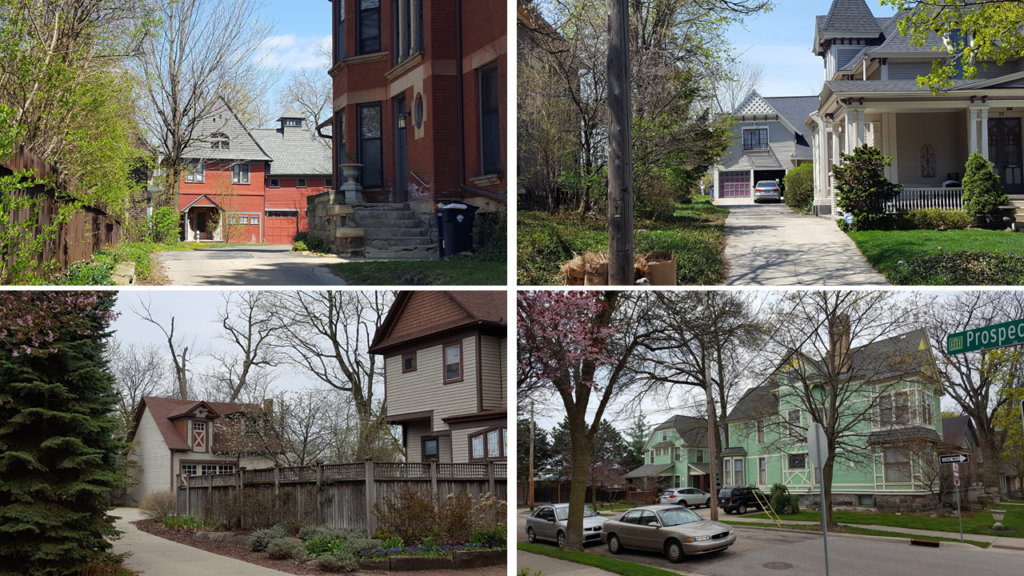In many of our historic neighborhoods, you can glimpse carriage houses behind the main homes. These two-story glorified garages typically date to the late 1800s, ranging from simpler barn-like structures to ornate smaller twins of the main house, and often included servants’ quarters on the upper story. Today, these carriage houses are big enough to support an apartment, spacious home office, or workshop; That is, when they’ve survived.

A sadly typical example of the form–the “historic building” plaque may be the only structurally sound part of the building.
To the chagrin of many in the historic preservation world, carriage houses are often allowed to decay, then demolished. If we look at the overall pattern and landscape of historic neighborhoods as something worth preserving, this is a loss, no matter how immaculately kept the main house may be. And to the property owner-especially one who bought the property with the carriage house already beyond reasonable repair-there are few incentives to invest in restoring them.
Enter the Accessory Dwelling Unit.
Perhaps the best tool cities have to support preservation of these structures is to make them economically productive assets for the homeowner by allowing-or even incentivizing-their reuse as small apartments. This is also an opportunity for older communities to start adding the “missing middle” of housing options back in to their mix.
Encouraging owners of historic homes to build ADUs in their carriage barns can be a more powerful preservation tool than any amount of enforcement-while supporting increased property values, population, and all the other benefits that ADUs offer to any neighborhood.

Some great examples of the carriage house ADU. At least I think they are–it can be hard to tell from the street whether these are lived in, which is why ADUs are sometimes called “invisible density”.
Coming from the other side, historic districts can be a great place for a community to take baby steps on ADUs. If a community has concerns about accessory dwelling units “fitting in” but isn’t ready to dive into writing a form-based code to address those concerns, an existing historic district already offers standards for making sure new units fit the local context. (Considering the historic activities these structures were originally used for, including living space, ADUs will often be a more context-appropriate option than a more passive use.)
So where should a community look to start?
First, ADUs need to be provided for in zoning. Under a conventional zoning ordinance, if there is no single zoning district that aligns well with the historic neighborhood in question, an overlay district may be the best way to match up new standards. Look to ordinance language like Grand Rapids’ for the type of provisions to include-within that sample, the critical enabling language is Residential Density. The ADU shall not be counted toward maximum residential density requirements.
(Under a form-based code, enabling carriage house ADUs can be done through a new building type entry: look to our Traverse City PlacePlan for an example, on pages 185-187 of the PDF.)
From there, consider exemptions from any policies that may make carriage house ADUs prohibitively expensive. For example, the cost to run dedicated water and sewer lines (plus tap fees!) will eat up a much larger slice of the total construction cost for a 500-square-foot ADU than for a new home. If ADUs are to be part of a historic preservation strategy, consider waiving tap fees, or allowing the ADU to tie into the existing laterals for the main house. (This will require working with your building official to identify proper backflow protections on the shared sewer lateral.) New-build requirements like a site plan-or even survey-might not make sense in the context of rehabilitating a century-old structure. Off-street parking requirements should be applied cautiously, if at all.
Finally, educating all involved on the rules and the intent will help get carriage houses off the endangered list: this should involve not just working with the historic district commission in developing standards, but proactive outreach to the owners of candidate carriage barns to put this opportunity on their radar. Realtors will also be important partners in helping prospective homeowners see their carriage barns as an opportunity, rather than a nuisance.